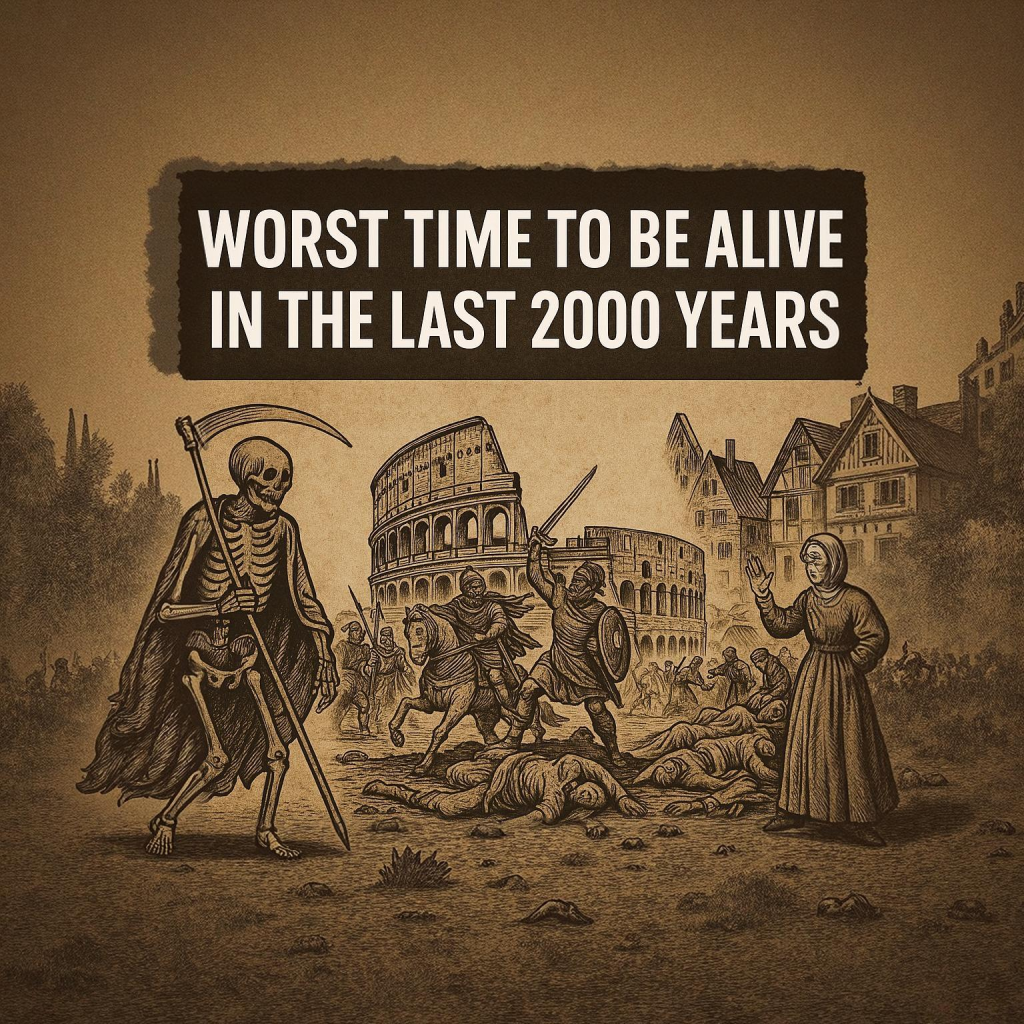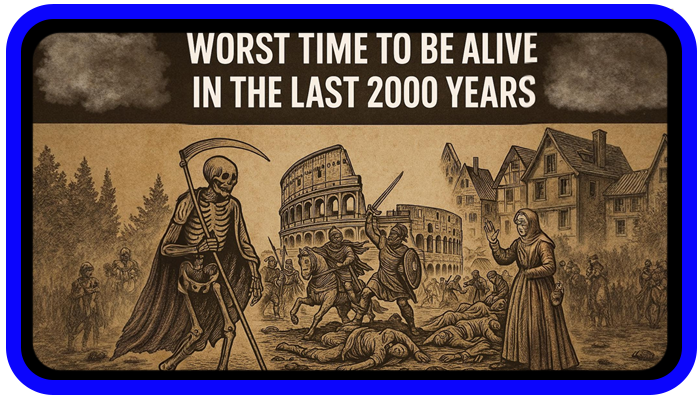⏲️ Estimated reading time: 5 min
Across the past two millennia, certain moments in history stand out as the absolute worst times to be alive. From pandemics and wars to environmental collapse, here’s when life on Earth was at its bleakest.
Worst Time to Be Alive in the Last 2000 Years
History is full of struggle, but some periods were so catastrophic that surviving them bordered on the miraculous. Whether due to disease, climate disaster, total war, or social collapse, these were moments when humanity teetered on the edge. This post explores some of the worst times to be alive in the last 2000 years, based on historical, medical, and environmental data.
☠️ 536 AD – The Worst Year in History
Many historians and scientists now agree: 536 AD was the single worst year to be alive in recorded human history. What happened?
What Made It So Terrible:
- A mysterious volcanic eruption (likely in Iceland) plunged much of the world into darkness.
- The sun dimmed for over 18 months, causing temperatures to plummet by 1.5°C to 2.5°C across the Northern Hemisphere.
- Crops failed, causing famine and starvation from Ireland to China.
- Widespread social and economic collapse followed, including the decline of major empires.
- It triggered the Late Antique Little Ice Age, lasting until around 660 AD.
- Just a few years later, the Plague of Justinian (541–549) killed an estimated 30–50 million people almost half the population of Europe.
This combination of climate catastrophe, economic ruin, and deadly disease makes 536 AD the darkest year in the last two millennia.
🏴 1347 – 1351 The Black Death
The Black Death (or Bubonic Plague) decimated Europe, Asia, and North Africa.
Why It Was Devastating:
- Originating from Central Asia, it spread along trade routes to Europe.
- Killed 75–200 million people worldwide, including 1 in 3 Europeans.
- Bodies piled in streets; cities turned into ghost towns.
- Led to massive social, economic, and religious upheaval.
- Some communities turned to persecution of members, like Jews, blamed for the plague.
There were no cures, no vaccines, and barely any understanding of how it spread. The death toll and suffering were unimaginable.
🌍 1914 – 1945 The 20th Century’s Age of Destruction
This era saw two World Wars, a global depression, and genocide.
Key Events:
- World War I (1914–1918): Over 16 million killed, with trench warfare and gas attacks introducing unprecedented horror.
- Spanish Flu (1918–1920): Infected one-third of the planet; killed at least 50 million.
- Great Depression (1929–1939): Global economic collapse led to poverty, hunger, and political extremism.
- World War II (1939–1945): Over 70 million deaths, including the Holocaust, atomic bombings in Hiroshima and Nagasaki, and massive civilian casualties.
This 30-year period ranks among the most traumatic in all human history.
🌋 1815 – 1816 The Year Without a Summer
After the eruption of Mount Tambora in Indonesia, global climate was severely disrupted.
Global Effects:
- 1816 saw snow in summer in the Northern Hemisphere.
- Massive crop failures in Europe, North America, and China.
- Famines killed tens of thousands; food riots broke out.
- In Switzerland, Mary Shelley wrote “Frankenstein” during a gloomy, volcanic ash-dimmed retreat.
While not as deadly as some other events, it was a miserable, hopeless year for millions worldwide.
🇨🇳 1850 – 1864 The Taiping Rebellion
This civil war in China is the bloodiest in human history outside of World War II.
What Happened:
- Led by a man claiming to be Jesus Christ’s brother.
- The rebellion against the Qing dynasty resulted in 20–30 million deaths.
- Brutal fighting, famine, and disease plagued the countryside.
- Cities were destroyed; the social fabric of China nearly collapsed.
It’s one of history’s forgotten catastrophes but was an apocalyptic time for the Chinese people.
🔥 1492 – 1600 The Columbian Exchange and Native American Collapse
While 1492 is remembered for Columbus “discovering” the Americas, it marked the start of genocide for millions.
Impact:
- European colonization brought new diseases like smallpox, measles, and influenza.
- 90% of Native American populations were wiped out in some areas within decades.
- Enslavement, war, and cultural destruction followed.
- The Atlantic Slave Trade soon emerged, forcing millions into bondage.
It was the end of worlds for entire civilizations.
📉 410 AD – The Sack of Rome
In 410, the Visigoths under King Alaric sacked the eternal city of Rome.
Why It Mattered:
- Rome had stood for over 800 years and symbolized civilization.
- The sack was shocking to the ancient world and marked the decline of the Western Roman Empire.
- It signaled a shift into the chaotic and violent early medieval period known as the Dark Ages.
For the Roman world, it was a psychological and cultural catastrophe.
💀 Other Notable Candidates
- Genghis Khan’s Invasions (13th century) – Killed tens of millions across Eurasia.
- Thirty Years’ War (1618–1648) – Devastated Germany; some regions lost 50% of their population.
- Holodomor Famine (1932–1933) – Millions died in Soviet Ukraine due to forced starvation.
- Rwandan Genocide (1994) – Over 800,000 people were massacred in 100 days.
- Atomic Age (1945–Present) – The threat of global nuclear annihilation has loomed since WWII.
🔚 The Bleakest Time: Final Analysis
If we had to choose one moment that stands above all others as the worst time to be alive, the consensus among historians and scientists is clear:
536 AD was the worst year in recorded human history.
It combined climate disaster, famine, disease, and global collapse, all without the modern tools to mitigate any of it.
What We Can Learn
Understanding history’s darkest times helps us:
- Appreciate how far humanity has come.
- Build resilience in the face of new challenges.
- Avoid repeating the same mistakes.
In an age of pandemics, climate change, and war, remembering the past is more vital than ever.
🔔 For more tutorials like this, consider subscribing to our blog.
📩 Do you have questions or suggestions? Leave a comment or contact us!
🏷️ Tags: worst years in history, black death, year 536, famines, climate disaster, historical plagues, wars, taiping rebellion, volcanic eruptions, global pandemics
📢 Hashtags: #HistoryFacts, #WorstYearEver, #DarkAges, #BlackDeath, #TaipingRebellion, #Plague, #VolcanicWinter, #Pandemics, #ClimateCollapse, #HistoricDisasters

History is filled with horror, but it’s also full of resilience. Human beings have survived plagues, wars, volcanic winters, and systemic collapse. The darkest times often give way to renewal, growth, and rebirth and perhaps that’s the most important lesson of all.
Only logged-in users can submit reports.
Discover more from HelpZone
Subscribe to get the latest posts sent to your email.

